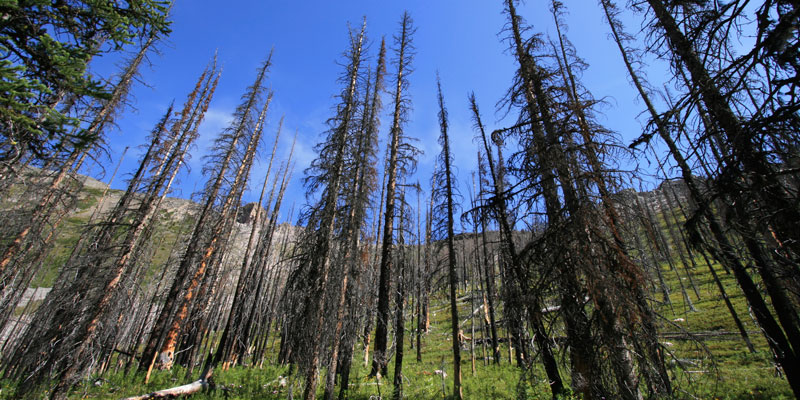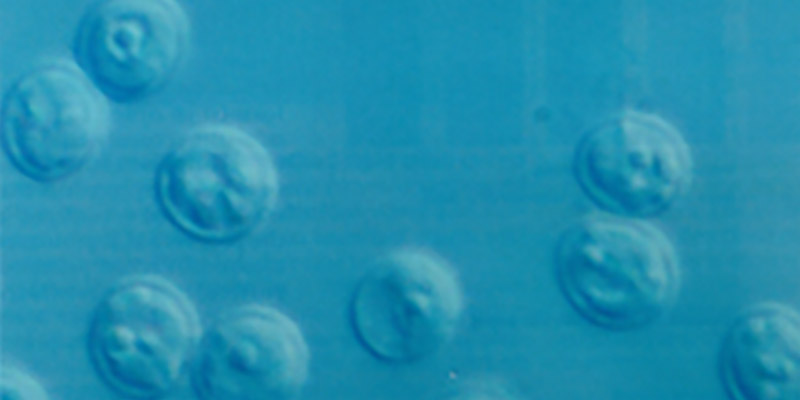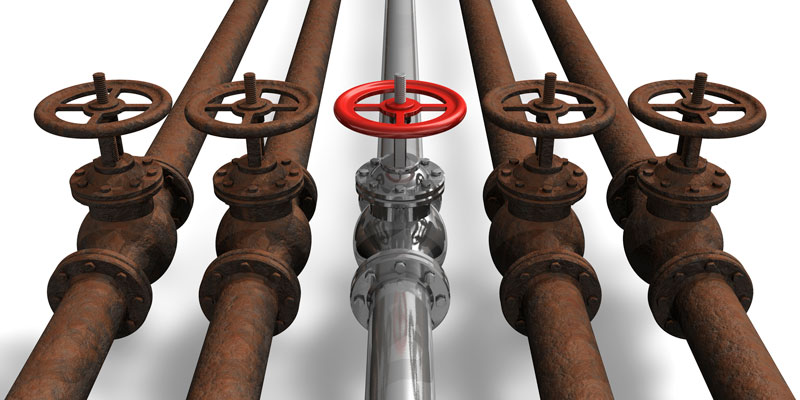Management of Wildfire Risk to Municipal Waterworks Systems in Alberta
Uldis Silins, Professor, University of Alberta (2012 - 2014)

Challenge
Forested regions in Alberta provide the majority of surface water supplies for drinking water for much of Albertas population. However, the importance of these water supplies has not been quantified. These forested regions are vulnerable to forest wildfire-associated contamination, which can be quite long lasting in Alberta. Recent increases in the magnitude of wildfires in Alberta and western Canada, along with increased provincial water demand, have resulted in a need to evaluate wildfire risk to downstream municipal drinking water supply and treatment systems. In partnership with the Government of Alberta, the broad goals of this research were to evaluate 1) the magnitude and likelihood of wildfire occurrence in critical source water regions in Alberta and 2) the potential impacts of these wildfire threats to downstream water utilities. This enabled assessing risks to municipal drinking water systems and served as a basis for evaluating the potential of existing and future management strategies to mitigate wildfire risks to drinking water security by end-users in Alberta, as well as elsewhere in Canada and abroad.
Project
Working in close partnership with key project partners in Alberta Environment and Sustainable Resource Development, this research investigated wildfire risk to municipal drinking water systems in Alberta and active forest management-based source water protection strategies for managing that risk.
The project evaluated these risks by linking wildfire threats (weather, vegetation-fuel, etc.) to source water supplies (water quality/quantity) and how these in turn, pose potential risks to water treatment utilities in Alberta. The work was divided into three phases or tiers, each representing major advances over existing wildfire risk assessment frameworks in North America or elsewhere.
Tier 1 of the research evaluated the coarse-resolution (provincial scale) risks from wildfire by linking the spatial distribution of wildfire threats (forest vegetation and fuel characteristics) to potential threats to water supplies (distribution of water production from forested regions) and linked these threats, in turn, to municipal utilities reliant on water supplies from these regions.
Phase 2 provided greater resolution in characterizing wildfire threat to municipal waterworks by linking historic wildfire behaviour in the major forest regions of Alberta (distribution of wildfire occurrence, size and severity) to variation in likely impacts on water supplies in each of these regions. Distribution of these threats among regions were evaluated in the context of key vulnerabilities for treatment utility infrastructure and key treatment thresholds that drive treatment process design and process performance during periods of changing water quality.
In Phase 3, a simulation modeling framework (vegetation-fuels, weather, fire behavior) was used to evaluate existing wildland fire mitigation strategies (prescribed fire, fuel management) specifically in the context of their efficacy in safeguarding key source water supplies and drinking water treatment operations. Detailed cost/benefit analysis of the outcome of management scenarios on drinking water treatment system performance were conducted and served as the basis for evaluating the impact of existing and future management strategies by end-users in Alberta.
The results from this project provided end users (municipal water utilities in Alberta) with a full analysis of wildfire risk to drinking water treatment in Alberta.
Outputs
- Development of a full-scale wildfire risk analysis framework that allows the potential risks of landscape disturbances on downstream drinking water supplies to be assessed in Alberta, as well as elsewhere in Canada and abroad.
To update end-users on progress and knowledge, researchers have participated and organized several meetings and workshops:
- 09/21/12: CWN project kick-off meeting, Edmonton, AB, audience: 12
- 10/16/12: Fire node meeting on Tier 1 conceptual approaches, Edmonton, AB, audience: 10
- 12/20/12: Drinking water node meeting regarding Alberta municipal drinking water treatment facility data issues, Edmonton, AB.
- 05/03/13: Node leader update meeting, University of Alberta, University of Waterloo, and Brock University
- 06/6-7/2013: Research team workshop to present and discuss the initial outcomes and to explore/discuss which parameters or metrics can be used to meaningfully link a) wildfire threats, to b) water supply threats, to c) vulnerability of downstream water treatment. Edmonton, AB, audience: 11
Researchers have disseminated knowledge through presentations:
- Silins, U. 2013. Shifting climates and water supply from forests: Implications for integrated water and land management. CWN Changing the Water Paradigm Conference, March 18-21, 2013, Ottawa, ON.Emelko, M.B. 2013. The Lost Creek wildfire of southern Alberta, Canada: 10 years, 7 watersheds and continued impacts. Water Research Foundation Wildfire Readiness and Response Workshop: Is Your Utility Prepared? April 4-5, 2013, Denver, CO.
- Emelko MB, Silins U, Stone M, Bladon KD, Wagner MJ, Williams CHS, and Martens AM. 2013. Long-term implications of wildfire to drinking water treatment. Healthy Forests = Healthy Waters specialty conference, American Water Resources Association, June 27-28, 2013, Hartford, CT,
- Bladon KD, Silins U, Flannigan MD, Emelko MB, Dupont DP, Kienzle KW, Parisien MA, Schroeder D, Stone M, Thompson DK, Tymstra C, Waddington MJ, Wang X, Woolford DG, and Wotton BM. 2013. Management of wildfire risk in forested regions of Alberta to downstream municipal drinking water treatment. Healthy Forests = Healthy Waters specialty conference, American Water Resources Association, June 27-28, 2013, Hartford, CT.
- Emelko MB, Geng X, Shams S, Bladon KD, Silins U, Stone M, Williams CHS, Wagner MJ, and Martens AM. 2013. Forested catchment fire and post-fire management: Implications to NOM character and treatability. NOM 2013 – IWA Natural Organic Matter Specialist Conference, International Water Association, October 1-4, 2013. Perth, Australia.
- Silins U, Emelko MB, Bladon KD, and Stone M. 2013. Assessing wildfire impacts on water quality and treatability: Which effects are attributable to wildfire? Water Quality and Technology Conference 2013, American Water Works Association, November 3-7, 2013, Long Beach, CA.
- Bladon KD, Silins U, Flannigan MD, Emelko MB, Dupont DP, de Groot B, Kienzle SW, Parisien MA, Robinne F, Schroeder D, Stone M, Thompson DK, Tymstra C, Wang X, Waddington JM,Woolford DG, and Wotton BM. 2013. Minimizing wildfire risk to municipal water works by active source water protection. Water Quality and Technology Conference 2013, American Water Works Association, November 3-7, 2013, Long Beach, CA,
- Emelko MB, Silins U, Bladon KD, and Stone M. 2013. Post-fire DOC, DBPs and nutrients: Justifying and achieving robust treatment. Water Quality and Technology Conference 2013, American Water Works Association, November 3-7, 2013, Long Beach, CA.
Outcomes
- The project provided partners and end users with a preliminary summary of the municipal drinking water treatment facilities at risk from wildfires in Alberta and the relative ranking of risk.
- Partners were provided with knowledge necessary for the prioritization of wildfire suppression responses to downstream “values at risk” and the early development of Drinking Water Safety plans now mandated for all provincial drinking water utilities in Alberta.
- The project also provided greater resolution of wildfire threats to drinking water treatment vulnerabilities, such as specific contaminants, necessary for more effective decision-making.
- An evaluation was completed of the effectiveness of existing and potential wildfire threat mitigation strategies on abatement of wildfire threats (i.e., fuel management programs) and resulting mitigation of potential impacts to drinking water treatment across Alberta’s treatment utilities.
- A detailed economic analysis was completed of the net benefits to residents of Alberta resulting from a range of wildfire threats mitigation strategies.




